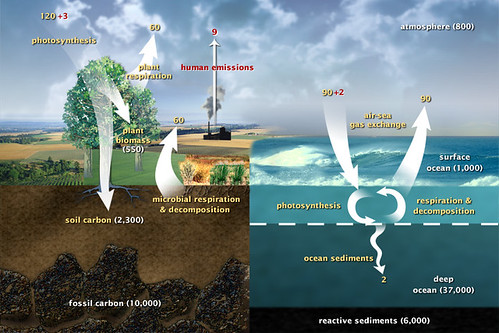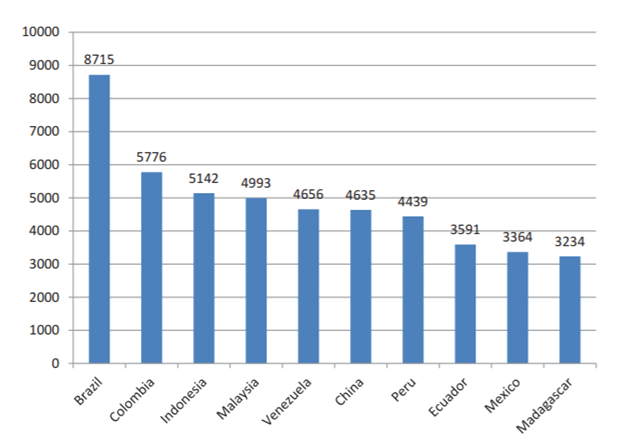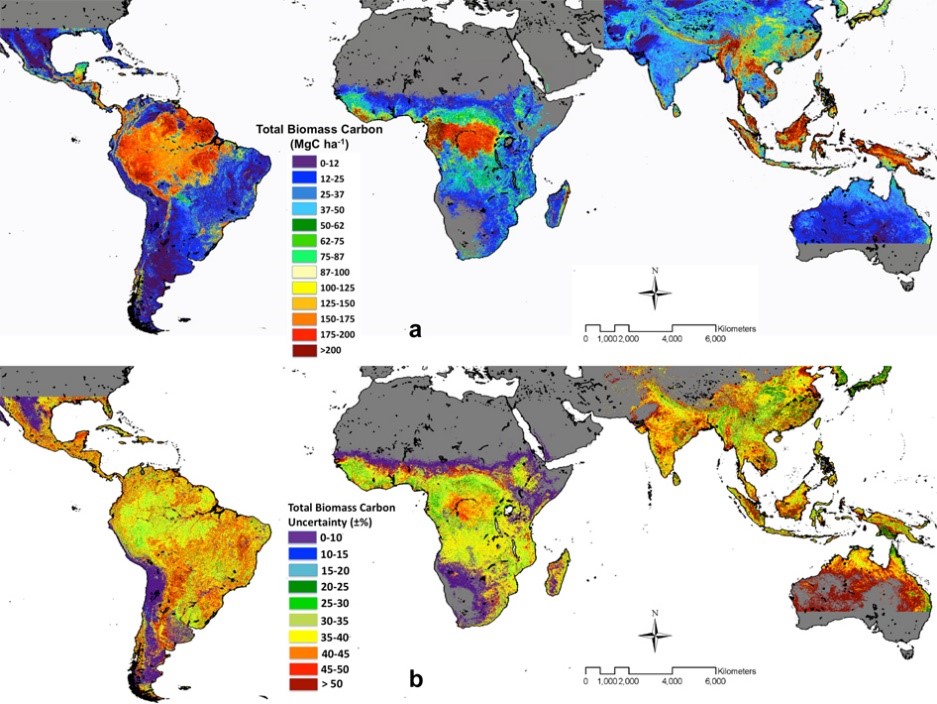Carbon is a foundation to all life on Earth [1]. Humans are made of carbon, we eat carbon, and our energy, homes, and transport are built from carbon. However, with human influence the carbon cycle has accelerated to release the highest concentrations of carbon dioxide in 2 million years, resulting in climate change [2]. Plants help store carbon dioxide from the atmosphere by absorbing it into their cells as they grow. When forests are cleared, all of the collected carbon in biomass is released. Often, they are replaced with crops and pastures, which store less carbon [3]. From 1990 to 2020, it is estimated that 420 million hectares of forest have been lost [4]. That is approximately 2 times the size of Greenland!

Figure 1 “Fast Carbon Cycle” by Atmospheric Infrared Sounder is licensed under CC BY 2.0
In an attempt to tackle and even reverse deforestation trends, ETH Zurich reported that planting a trillion trees has the potential to remove 25% (205 billion tons) of carbon stored in the atmosphere [5]. However, mustering the financial commitments necessary to do this depends on providing evidence that the carbon is actually being sequestered. The secret to a successful, sustainable, financeable and largescale reforestation model is accurately tracking and quantifying carbon. Yet, doing so reliably at scale is a major challenge.
Having joined Taking Root earlier this summer as a Research Assistant, I have been working on helping to build a database of aboveground biomass models. So, what does that mean? And what does it have to do with carbon storage and reforestation?
First, let me explain what aboveground biomass is…
Simply put, aboveground biomass is the dry weight (kg) of all tree components above the soil. Previously, measuring tree biomass involved cutting the tree down into components, weighing the components in the field (fresh weight) and then oven-drying sections at a specific temperature (~70°C) to a constant weight [6]. This process can be costly and time consuming.
In the interest of saving time and sparing the trees we are trying to plant, academics have developed allometric equations. Using these equations, we can now determine biomass using easily measured variables such as height, diameter of the trunk and/or stump, and wood density (the weight at a specific moisture content level).
Aboveground biomass is important for determining the ability of a specific tree to sequester carbon. By creating a database of these equations, we can create a reliable source of information for measuring carbon. This is critical for conservation and reforestation projects who need to build credibility. Often, these projects depend on funding, which is difficult to obtain without standardized methods of monitoring and regulating. For example, Taking Root uses allometric equations to quantify the amount of carbon stored in trees we grow and generate carbon credits on behalf of the farmers we work with.
Each tree species sequesters carbon at different rates, and outside influences such as tree age, stem diameter, tree height, soil conditions, climate, and planting layout can create even more variability [7]. Therefore to achieve accuracy, the biomass equation should be created specific to that climate and species. This becomes problematic across tree growing initiatives when you consider the fact that there are at least 40,000 types of tropical tree species [8].

Figure 2 The top 10 countries with the most tree species. From Beech et al. 2017
Fun Fact: Tropical climates contain the highest levels of biodiversity and carbon sequestration potential [9] [10]. Tropical deforestation alone releases 3.0 billion tons of carbon dioxide every year, contributing to 10% of global warming [11]. That is equivalent to the annual emissions of 600 million cars [12].
Astonishingly, an aboveground biomass database does not yet exist for the tropics!

Figure 3 NASA Map Reveals Tropical Forest Carbon Storage. By Buis,A., and Cole,S. 2011
Creating an accessible collection of biomass models will aid academics in building their own databases, facilitating deforestation research, and fueling reforestation projects. Accessibility also allows for the database to continue growing. There are thousands of tropical biomass equations out there, and there will be more developed in the future. By accepting public input we can provide a resource for current and prospective projects while creating opportunities to further research.
Taking Root will benefit from this database after downloading it into their FARM-TRACE application. FARM-TRACE is a platform developed to automate the monitoring of trees, forest cover, and carbon over time. The system creates randomised sampling plots on mapped parcels and connects each tree monitored via its mobile application with the closest biomass equation to quantify the total carbon stored on each farm. This data is then connected to satellite imagery and used to train a localised machine algorithm specific to the ecoregion of the parcel to track forest and carbon metrics on an ongoing basis. The more biomass models in the system means the more accurate the data, both for the field inventories and the remotely sensed forest tracking. As we know it, this is going to be the largest and most complete database in the world! This is why I have been compiling aboveground biomass equations. Creating a means to calculate tropical tree biomass is going to be crucial if we want to tackle climate change through reforestation [13].
How Taking Root automates in-field forest inventories using the FARM-TRACE mobile application.
According to the FAO (Food and Agriculture Organization), the key to the conservation of the world’s biodiversity, food security, and well-being of all peoples, lies within the sustainable management of forests. This begins with effective and targeted funding into science-based interventions on the basis of robust impact monitoring and measurement techniques.
For more information about Taking Root’s work or to learn more about the FARM-TRACE platform contact us at info@takingroot.org[:]